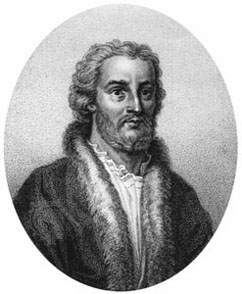| Sir John Oldcastle  Born: c. 1378 Born: c. 1378
Birthplace: Herefordshire, England
Died: 14-Dec-1417
Location of death: London, England
Cause of death: Execution
Gender: Male
Race or Ethnicity: White
Sexual orientation: Straight
Occupation: Military Nationality: England
Executive summary: Lollard rebel leader English Lollard leader, the son of Sir Richard Oldcastle of Almeley in Herefordshire. He is first mentioned as serving in the expedition to Scotland in 1400, when he was probably quite a young man. Next year he was in charge of Builth castle in Brecon, and serving all through the Welsh campaigns won the friendship and esteem of Henry, the prince of Wales. Oldcastle represented Herefordshire in the parliament of 1404. Four years later he married Joan, the heiress of Cobham, and was thereon summoned to parliament as Lord Cobham in her right. As a trusted supporter of the prince, Oldcastle held a high command in the expedition which the young Henry sent to France in 1411. Lollardy had many supporters in Herefordshire, and Oldcastle himself had adopted Lollard opinions before 1410, when the churches on his wife's estates in Kent were laid under interdict for unlicensed preaching. In the convocation which met in March 1413, shortly before the death of Henry IV, Oldcastle was at once accused of heresy. But his friendship with the new king prevented any decisive action until convincing evidence was found in a book belonging to Oldcastle, which was discovered in a shop in Paternoster Row. The matter was brought before the king, who desired that nothing should be done until he had tried his personal influence. Oldcastle declared his readiness to submit to the king "all his fortune in this world", but was firm in his religious beliefs. When he fled from Windsor to his own castle at Cowling, Henry at last consented to a prosecution. Oldcastle refused to obey the archbishop's repeated citations, and it was only under a royal writ that he at last appeared before the ecclesiastical court on the 23rd of September. In a confession of his faith he declared his belief in the sacraments and the necessity of penance and true confession; but to put hope, faith or trust in images was the great sin of idolatry. But he would not assent to the orthodox doctrine of the sacrament as stated by the bishops, nor admit the necessity of confession to a priest. So on the 25th of September he was convicted as a heretic. Henry was still anxious to find a way of escape for his old comrade, and granted a respite of forty days. Before that time had expired Oldcastle escaped from the Tower of London by the help of one William Fisher, a parchment-maker of Smithfield (Riley, Memorials of London, 641). Oldcastle now put himself at the head of a widespread Lollard conspiracy, which assumed a definitely political character. The design was to seize the king and his brothers during a Twelfth-night mumming at Eltham, and perhaps, as was alleged, to establish some sort of commonwealth. Henry, forewarned of their intention, removed to London, and when the Lollards assembled in force in St. Giles's Fields on the 10th of January they were easily dispersed. Oldcastle himself escaped into Herefordshire, and for nearly four years avoided capture. Apparently he was privy to the Scrope and Cambridge plot in July 1415, when he stirred some movement in the Welsh Marches. On the failure of the scheme he went again into hiding. Oldcastle was no doubt the instigator of the abortive Lollard plots of 1416, and appears to have intrigued with the Scots. But at last his hiding place was discovered and in November 1417 he was captured by the Lord Charlton of Powis. Oldcastle who was "sore wounded ere he would be taken", was brought to London in a horse-litter. On the 14th of December he was formally condemned, on the record of his previous conviction, and that same day was hung in St. Giles's Fields, and burnt "gallows and all." It is not clear that he was burnt alive.
Oldcastle died a martyr. He was no doubt a man of fine quality, but circumstances made him a traitor, and it is impossible altogether to condemn his execution. His unpopular opinions and early friendship with Henry V created a traditional scandal which long continued. In the old play The Famous Victories of Henry V, written before 1588, Oldcastle figures as the prince's boon companion. When Shakespeare adapted that play in Henry IV, Oldcastle still appeared; but when the play was printed in 1598 Falstaff's name was substituted, in deference, as it is said, to the then Lord Cobham. Though the fat knight still remains "my old lad of the Castle", the stage character has nothing to do with the Lollard leader.
Father: Sir Richard Oldcastle
Wife: Joan (m. 1408)
UK Member of Parliament for Herefordshire (1404)
Inmate: Tower of London
Heresy 25-Sep-1413 (convicted)
Requires Flash 7+ and Javascript.
Do you know something we don't?
Submit a correction or make a comment about this profile
Copyright ©2019 Soylent Communications
|